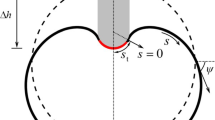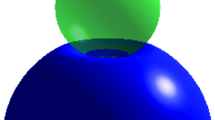Abstract
This article studies the effect of the geometry of the probe on the nanoindentation of a virus. Theoretical continuum models and numerical simulations are presented for two different probes with different shapes, namely cylindrical probes with a spherical end and cylindrical probes with a flat end. The finite element method is used and the numerical results show that the use of the probe with a spherical end reflects more nonlinearity, probably due to the Hertz effect.










Similar content being viewed by others
References
Borodich, Feodor M.: The hertz-type and adhesive contact problems for depth-sensing indentation. Adv. Appl. Mech. 47, 225–366 (2014)
Borodich, F.M., Keer, L.M.: Evaluation of elastic modulus of materials by adhesive (no-slip) nano-indentation. Proc. Math. Phys. Eng. Sci. 460(2042), 507–514 (2004)
Bousquet, A., Dragnea, B., Tayachi, M., Temam, R.: Towards the modeling of nanoindentation of virus shells: do substrate adhesion and geometry matter? Phys. D Nonlinear Phenom. 336, 28–38 (2016)
Bustamante, C., Macosko, J.C., Wuite, G.J.L.: Grabbing the cat by the tail: manipulating molecules one by one. Nat. Rev. Mol. Cell Biol. 1(2), 130–136 (2000)
Carrasco, C., Carreira, A., Schaap, I.A.T., Serena, P.A., Gmez-Herrero, J., Mateu, M.G., de Pablo, P.J.: DNA-mediated anisotropic mechanical reinforcement of a virus. Proc. Natl. Acad. Sci. 103(37), 13706–13711 (2006)
Clifford, C.A., Seah, M.P.: Nanoindentation measurement of youngs modulus for compliant layers on stiffer substrates including the effect of poissons ratios. Nanotechnology 20(14), 145708 (2009)
Duvaut, G., Lions, J.-L.: Inequalities in Mechanics and Physics. Springer, Berlin-New York (1976)
Finkin, E.F.: The determination of young’s modulus from the indentation of rubber sheets by spherically tipped indentors. Wear 19(3), 277–286 (1972)
Ford, L.H.: Estimate of the vibrational frequencies of spherical virus particles. Phys. Rev. E Stat. Nonlinear Soft. Matter. Phys. 67, 1539–3755 (2003)
Gibbons, M.M., Klug, W.S.: Nonlinear finite-element analysis of nanoindentation of viral capsids. Phys. Rev. E 75, 031901 (2007)
Goodman, L.E., Keer, L.M.: The contact stress problem for an elastic sphere indenting an elastic cavity. Int. J.Solids Struct. 1(4), 407–415 (1965)
Hernando-Perez, M., Zeng, C., Delalande, L., Tsvetkova, I.B., Bousquet, A., Tayachi-Pigeonnat, M., Temam, R., Dragnea, B.: Nanoindentation of isometric viruses on deterministically corrugated substrates. J. Phys. Chem. B 120(2), 340–347 (2016)
Johnson, K.L.: Contact Mechanics. Cambridge University Press, Cambridge (1987)
Kikuchi, N., Oden, J.T.: Contact problems in elasticity: a study of variational inequalities and finite element methods. In: SIAM, Studies in Applied and Numerical Mathematics (1988)
Lev, D., Lifshitz, E.M.: Theory of elasticity, vol. 7. Course of theoretical. Physics 3, 109 (1986)
Lawn, B.R.: Indentation of ceramics with spheres: a century after hertz. J. Am. Ceram. Soc. 81(8), 1977–1994 (1998)
Lin, D.C., Shreiber, D.I., Dimitriadis, E.K., Horkay, F.: Spherical indentation of soft matter beyond the hertzian regime: numerical and experimental validation of hyperelastic models. Biomech. Model. Mechanobiol. 8(5), 345–358 (2009)
Liu, D.X., Zhang, Z.D., Sun, L.Z.: Nonlinear elastic load-displacement relation for spherical indentation on rubberlike materials. J. Mater. Res. 25(11), 2197–2202 (2010)
Long, R., Hall, M.S., Mingming, W., Hui, C.-Y.: Effects of gel thickness on microscopic indentation measurements of gel modulus. Biophys. J. 101(3), 643–650 (2011)
Machado, M., Moreira, P., Flores, P., Lankarani, H.M.: Compliant contact force models in multibody dynamics: evolution of the hertz contact theory. Mech. Mach. Theory 53, 99–121 (2012)
Mateu, M.G.: Structure and Physics of Viruses. An Integrated Textbook, vol. 68. Springer, Dordrecht (2013)
Mesarovic, S.D.J., Fleck, N.A.: Spherical indentation of elastic–plastic solids. Proc. Math. Phys. Eng. Sci 455(1987), 2707–2728 (1999)
Michel, J.P., Ivanovska, I.L., Gibbons, M.M., Klug, W.S., Knobler, C.M., Wuite, G.J.L., Schmidt, C.F.: Nanoindentation studies of full and empty viral capsids and the effects of capsid protein mutations on elasticity and strength. Proc. Natl. Acad. Sci. 103(16), 6184–6189 (2006)
Montmitonnet, P., Edlinger, M.L., Felder, E.: Finite element analysis of elastoplastic indentation: part II-application to hard coatings. J. Tribol. 115(1), 15–19 (1993)
Rodriguez, J., Garrido, M.A.: Maneiro. A procedure to prevent pile up effects on the analysis of spherical indentation data in elastic-plastic materials. Mech. Mater. 39(11), 987–997 (2007)
Roos, W.H.: How to perform a nanoindentation experiment on a virus. Single Molecule Analysis. Methods in Molecular Biology, vol. 783, pp. 251–264. Humana Press, New York City (2011)
Roos, W.H., Bruinsma, R., Wuite, G.J.L.: Physical virology. Nat. Phys. 6(10), 733–743 (2010)
Roos, W.H., Gibbons, M.M., Arkhipov, A., Uetrecht, C., Watts, N.R., Wingfield, P.T., Steven, A.C., Heck, A.J.R., Schulten, K., Klug, W.S., Wuite, G.J.L.: Squeezing protein shells: how continuum elastic models, molecular dynamics simulations, and experiments coalesce at the nanoscale. Biophys. J. 99(4), 1175–1181 (2010)
Temam, R., Miranville, A.: Mathematical Modeling in Continuum Mechanics, 2nd edn. Cambridge University Press, Cambridge (2005)
Twarock, R.: Mathematical virology: a novel approach to the structure and assembly of viruses. Philos. Trans. R. Soc. Lond. A Math. Phys. Eng. Sci. 364(1849), 3357–3373 (2006)
Sampath, S.K., Narasimhan, R.: A numerical analysis of spherical indentation response of thin hard films on soft substrates. Int. J. Solids Struct. 43(20), 6180–6193 (2006)
Vaughan, R., Tragesser, B., Ni, P., Ma, X., Dragnea, B., Kao, C.C.: The tripartite virions of the brome mosaic virus have distinct physical properties that affect the timing of the infection process. J. Virol. 88(11), 64836491 (2014)
Zhu X. Tutorial on Hertz Contact Stress. https://wp.optics.arizona.edu/optomech/wp-content/uploads/sites/53/2016/10/OPTI-521-Tutorial-on-Hertz-contact-stress-Xiaoyin-Zhu.pdf (2012)
Acknowledgements
This research was supported in part by the National Science Foundation under the Grants NSF-DMS-1510249, by the Research Fund of Indiana University. The authors thank Pierre Suquet for introducing them to the Hertz effect, and Bogdan Dragnea for many useful discussions.
Author information
Authors and Affiliations
Corresponding author
Additional information
This article is dedicated to Chi-Wang Shu on the occasion of his 60th birthday, with friendship and much appreciation for his scientific contributions and for his services to the community.
Rights and permissions
About this article
Cite this article
Hou, Y., Temam, R. About the Modeling of the Indentation of a Virus Shell: The Role of the Shape of the Probe. J Sci Comput 73, 783–796 (2017). https://doi.org/10.1007/s10915-017-0481-0
Received:
Revised:
Accepted:
Published:
Issue Date:
DOI: https://doi.org/10.1007/s10915-017-0481-0




